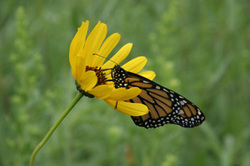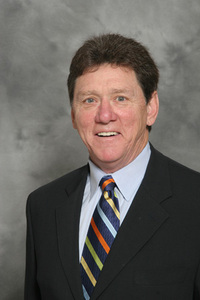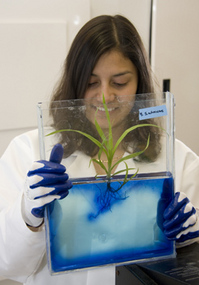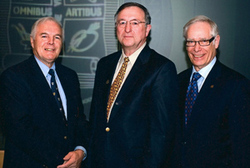The University of Minnesota, Crookston contributes $50 million annually to the local and regional economy, according to a study recently completed by University of Minnesota Extension's Center for Community Vitality. The economic impact of the Crookston campus supports a total of 602 jobs and $25.1 million in labor income. The study factored the economic contributions of faculty and staff spending, construction projects, daily operations, student spending, and spending by visitors at campus events in 2009.
"We've always known that the U of M, Crookston has a positive effect on our region in the areas of community service and quality of life. With this study we are able to quantify the impact our campus has on our local economy," said U of M, Crookston Chancellor Charles Casey, D.V.M., "and it certainly is significant."
The study reports the U of M, Crookston contributed--via direct expenditures and related ripple effects--a total of $50 million in economic activity to the economy of the Crookston/Grand Forks region in 2009. Of that:
-
Spending by faculty and staff employed by the U of M, Crookston contributed $27.4 million and 366 jobs to the regional economy.
-
Spending by the University on construction projects on campus contributed $7.5 million and 65 jobs to the regional economy.
-
Spending by the University on daily operations contributed a total of $7.2 million and 73 jobs to the regional economy.
-
Spending by U of M, Crookston students contributed $6.96 million and 81 jobs to the regional economy.
-
Spending by visitors from outside the region to events held on the Crookston campus contributed $1.1 million and 19 jobs to the regional economy.
The direct impact is equivalent to the spending by the University, its employees, its students, and visitors from outside the region. The indirect impact is the summation of changes in the local economy that occur due to spending for goods and services; as the University purchase items, its suppliers must replace them and/or increase their production. As these ripples move through the economy, they can be measured, and such ripples related to the purchase of goods and services are indirect impacts. Induced impacts are effects in the local economy that occur due to spending by employees to purchase housing, to buy gas, groceries, and personal items, and to go out to dinner.
In 2009 the largest segment of the U of M, Crookston's economic impact came from spending by the 257 faculty and staff directly employed by the campus. The campus is among the top five employers in Crookston. The impact in labor income was $14.7 million, the annual payroll, with an additional $3.5 million in ripple effects, and a total direct, indirect, and induced output of $27.4 million and 109 additional jobs. Essentially, because these 257 employees earned their paychecks from the University and spent the bulk of their money in the region, they supported 109 additional jobs that would not otherwise exist.
Spending by the 1,310 degree-seeking students enrolled at the Crookston campus added nearly $7 million in additional economic output and supported 81 regional jobs. And visitors (such as family, friends, and rival athletics teams from outside the region) who came to the campus for various events throughout the year, contributed over $1 million in economic output and supported 19 jobs.
Residents of Crookston and the region benefit in many ways in addition to the $50 million in economic impact, according to Chancellor Casey. "Because the University of Minnesota has this campus in Crookston, roughly $10 million in state tax dollars returns to the region in the form of state operational support for the campus. Taxpayers see a direct investment by the state of Minnesota in this community."
Campus activities like athletic events, performers, plays, concerts, speakers, presentations, alumni events, and graduation contribute to the quality of life for residents of the community in addition to the money campus visitors attending those events bring into the local economy.
Casey added that whenever possible the campus makes a priority of purchasing items and services from local and regional businesses. "The University takes its role as a community member very seriously, and we want people to know we purchase locally to support our region's economy," he added.
While the U of M, Crookston collaborates with University of Minnesota Extension's Regional Center and the Northwest Research and Outreach Center (NWROC), which are co-located on the Crookston campus, the report did not include expenditures by or effects from Extension or NWROC. The three units are distinct and operate separately.
The economic contribution of the U of M, Crookston was calculated using input-output modeling software and data from IMPLAN (IMpact analysis for PLANning) by Minnesota IMPLAN Group, Inc. The primary study area for the report was the greater Crookston region, including Polk County, Minnesota, and Grand Forks County, North Dakota.
The IMPLAN model traces the flow of dollars throughout a local economy and captures the indirect and induced, or ripple effects, of that economic activity. Researchers involved in the process made use of actual payroll and operating expenditure data from the Business Affairs Office at the U of M, Crookston, giving a high degree of accuracy or "ground-truthing."
Primary researchers and authors of the report were Brigid Tuck, Arthur Nash, and David Nelson of University of Minnesota Extension. The report was peer reviewed by Bruce Sorte, visiting associate Extension professor and William Lazarus, professor in the Department of Applied Economics, Twin Cities campus. The full report is available online at:
www.umcrookston.edu/chancellors-office/documents/UMC-EconomicImpact2010.pdf.
Today the University of Minnesota, Crookston delivers 29 bachelor's degree programs, 18 minors, and 40 concentrations, including several online degrees, in the areas of agriculture and natural resources; business; liberal arts and education; and math, science, and technology. With an enrollment of 1,300 undergraduates from more than 25 countries and 40 states, the Crookston campus offers a supportive, close-knit atmosphere that leads to a prestigious University of Minnesota degree. "Small Campus. Big Degree." To learn more, visit www.umcrookston.edu.
Contact: Andrew Svec, director of communications, public relations, and marketing; Art Nash, assistant Extension professor, 218-281-8689; David Nelson, regional Extension educator, community economics,507-389-6660
 trees they have visited for generations. In order to understand the migration habits of the monarch and protect precious habitat, the butterflies are tagged in late August just before they begin their fall migration.
trees they have visited for generations. In order to understand the migration habits of the monarch and protect precious habitat, the butterflies are tagged in late August just before they begin their fall migration.




